Related Research Articles

Pope Alexander VIII, born Pietro Vito Ottoboni, was head of the Catholic Church and ruler of the Papal States from 6 October 1689 to his death in 1691. He is to date the last pope to take the pontifical name of "Alexander" upon his election to the papacy.

Pietro da Cortona was an Italian Baroque painter and architect. Along with his contemporaries and rivals Gian Lorenzo Bernini and Francesco Borromini, he was one of the key figures in the emergence of Roman Baroque architecture. He was also an important designer of interior decorations.
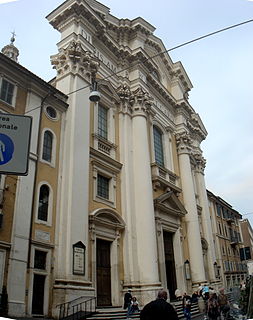
Sant'Ambrogio e Carlo al Corso is a basilica church in Rome, Italy, facing onto the central part of the Via del Corso. The apse of the church faces across the street, the Mausoleum of Augustus on Via di Ripetta.

Giuseppe Maria Crespi, nicknamed Lo Spagnuolo, was an Italian late Baroque painter of the Bolognese School. His eclectic output includes religious paintings and portraits, but he is now most famous for his genre paintings.

Carlo Maratta or Maratti was an Italian painter, active mostly in Rome, and known principally for his classicizing paintings executed in a Late Baroque Classical manner. Although he is part of the classical tradition stemming from Raphael, he was not exempt from the influence of Baroque painting and particularly in his use of colour. His contemporary and friend, Giovanni Bellori, wrote an early biography on Maratta.
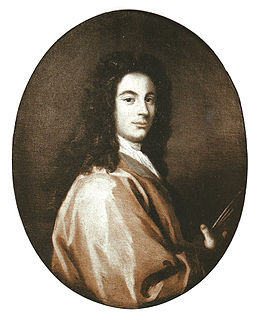
Antonio Balestra was an Italian painter of the Rococo period.

The Basilica of San Giovanni dei Fiorentini is a minor basilica and a titular church in the Ponte rione of Rome, Italy.

Pietro della Vecchia, Pietro della Vècchia or Pietro Vècchia, formerly incorrectly called Pietro Muttoni was a versatile Italian painter who worked in many genres and created altarpieces, portraits, genre scenes and grotesques. He also created pastiches of the work of leading Italian painters of the 16th century. He designed cartoons for mosaics and worked as an art restorer. Della Vecchia was also sought after as an art expert and did expert valuations of artworks. He worked most of his life in Venice and its environs except for a brief stay in Rome.

Lorenzo Pasinelli was an Italian painter active mainly in Bologna during the late Baroque period.
Events from the year 1690 in art.
Giuseppe Natali (1652–1722) was an Italian painter of the Baroque period, active mainly in Cremona and Lombardy.
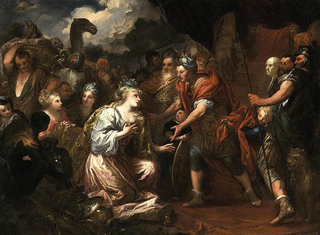
Pietro Dandini was an Italian painter of the Baroque period, active mainly in Florence.
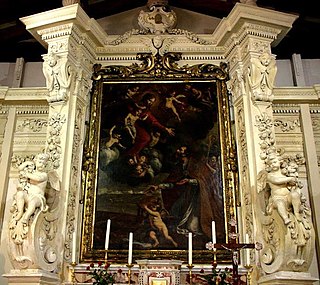
Giovanni Quagliata (1603–1673) was an Italian painter of the Baroque period. He is more properly known in Italy as Giovan Battista Quagliata, one of the leading artists of the Messinesi painters of the 17th century, as described by Francesco Susinno in his book "The Lives of the Messinesi Painters" published in 1724. Giovanni was born in Messina, Italy. He was a pupil of Pietro da Cortona and enjoyed the patronage and friendship of the Spanish Viceroy of Sicily, Don Juan José of Austria. Giovanni's brother, Andrea Quagliata, was also an historical painter, but of lesser significance. Giovanni's works – paintings, frescoes and large canvases – were famously displayed in the galleries and churches of Messina, but due to earthquakes from Mount Etna and wartime bombings, few have survived to the present day.

Giovanni Monevi or Monevo was an Italian painter of the Baroque period. The name Giovanni Moneri is used by a number of authors, but may reflect a misspelling.
Giovanni Lorenzo Lulier, nicknamed Giovannino del Violone was a Baroque Italian composer, cellist and trombone player of Spanish descent.
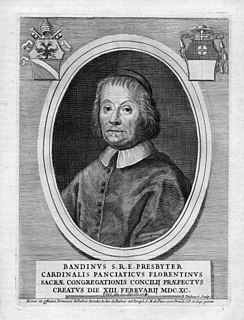
Bandino Panciatici as a Roman Catholic cardinal from 1690 to 1718.

Giacomo Cantelmo was a Roman Catholic cardinal from 1690 to 1702.

Franciscus de Neve (II) was a Flemish painter and engraver. He is known for his late Baroque religious and mythological scenes and landscapes. He had an international career in Italy, Southern Germany and Austria where he worked for aristocratic patrons and churches; He returned to his native Flanders later in his life.

Dionisio Montorselli was an Italian painter of the late-Baroque period.

Pietro Gagliardi was an Italian painter and architect, who decorated many churches and palaces in Rome and throughout Italy.
References
- Bryan, Michael (1889). Walter Armstrong; Robert Edmund Graves (eds.). Dictionary of Painters and Engravers, Biographical and Critical. Vol. II L-Z. London: George Bell and Sons. p. 67.